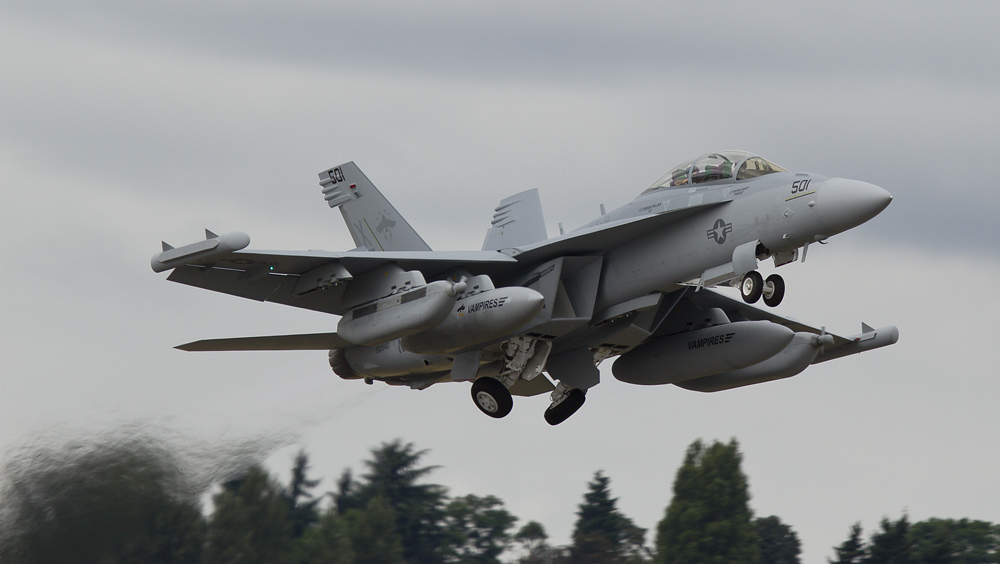Early this week numerous reports announced the government's intention to purchase Boeing F/A-18E/F Super Hornets as an interim replacement to the RCAF's aging fleet of McDonnell-Douglas CF-18 Hornets.
Canada's current CF-18 fleet is quickly approaching the point of no return when it comes to hours flown. The majority of the 77 remaining active CF-18s have flown close to an average of 6,000 hours each. In fighter-jet mileage - that is like running your car past 200,000 kms and expecting it to continue working like new. Except the CF-18s are not new - they were all built in the 1980s so Minister of Defence Sajjan was right when he said a replacement is needed sooner rather than later.
I personally do not think an interim solution is needed. If a decision on a complete fleet replacement is made within the next 2-3 years; and deliveries start by 2021 - the entire fleet will be replaced before 2025; and the current retirement date of Canada's CF-18s. So a gap in capabilities? Perhaps this is being fabricated.
However, if you want to fill a gap that currently exists; purchase a small number of EA-18 Growlers instead of Super Hornets. While the RCAF has argued against the creation of a mixed fleet for years; whether it is the Super Hornets or Growlers, they need to get over it. The Super Hornet and CF-18's are not the same aircraft and will need to be in mixed fleets. If done correctly costs are not as big of an issue as the RCAF makes it seem to be. Besides, before the CF-18s were introduced the RCAF operated 3 different fighters; the CF-104 Starfighter, the CF-101 Voodoo and the CF-115 (or CF-5) Freedom Fighter. Understandably the RCAF does not want to maintain 3 different aircraft. The Growler, like the Super Hornet is a 80%+ clone of the original Hornet.
So why should Canada look to purchase E/A-18 Growlers instead of Super Hornets? Simply because it fills a gap in the RCAF's current capabilities - electronic warfare.
| Features of the new RAAF Growlers from the RAAF. |
- OPERATIONS DESSERT SHIELD & STORM (Iraq -1999)
- Deployment of 24 CF-18s; which completed 2,700 sorties, 56 bombing missions and flew more than 5,700 hours.
- OPERATIONS MIRADOR, ECHO, & KINETIC (Former Yugoslavia -1997-1999)
- Deployment of 18 CF-18s; which completed 327 sorties, dropped 532 bombs, and flew more than 2,600 hours.
- OPERATIONS MOBILE & UNIFIED PROTECTOR ( Libya - 2011)
- Deployment of 7 CF-18s; which completed 946 sorties, dropped 696 bombs, and flew more than 3,880 hours.
- OPERATION IMPACT (Iraq - 2014-2016)
- Deployment of 6 CF-18s; which completed 1,378 sorties, dropped 606 bombs, and flew more than 4,000 hours.
While the CF-18 is an agile multi-role combat aircraft; more than capable of attacking ground targets we know it is not stealth; and has no electronic warfare capabilities. The E/A-18 Growler on the other hand could easily be attached to a Squadron of CF-18s and provide that capability on sorties while also being able to attack ground targets easily.
The E/A-18 Growler is a clone of the F/A-18E/F Super Hornet; but with electronic warfare equipment installed, and the leading edge of the wings adapted. Boeing began testing the idea of the Growler early in 2001 after the initial flights of the Super Hornet. The fully developed Growler entered service in 2009. So it is a much newer aircraft that the Super Hornet.
According to the Canadian American Strategic Review, The Growler is the 'Electronic Attack ' variant of the Super Hornet family. Growler operates in a way that is diametrically opposed to stealth aircraft like the F-35. Rather than hide from a threat radar, the Growler hunts them. Equipped with sophisticated jamming equipment and armed with 'anti-radiation' missiles for attacking ground-based radar, theGrowlers carry out their Suppression of Enemy Air Defence (SEAD) missions. Growler flies its SEAD missions either in the traditional stand-off jamming role or as a close escort – protecting other strike aircraft. This Electronic Attack capability is in short supply within NATO and added SEAD capability from Canada would be more welcomed by the Alliance than extra strike aircraft.
Critics of the governments announcement to buy Super Hornets point to Australia and their decision to by 24 Super Hornets as an interim solution while waiting for their 70 F-35s. The same people should mention that Australia also purchased 12 E/A-18 Growlers to help those Super Hornets. Australia expects its Growlers to begin operations in 2017 and be fully operational by 2022.
So even if the government officially announces an interim purchase of F/A-18 Super Hornets; don't expect deliveries tomorrow - they would most likely start taking place in 2018 - behind the Australians, and the US Marine Corps which also purchased more while waiting for the F-35.
To sum up simply - Canada should consider E/A-18 Growlers as a true interim solution to the aging CF-18 Fleet.
 |
| USAF E/A-18 Growler - Russel Hill |
No comments:
Post a Comment